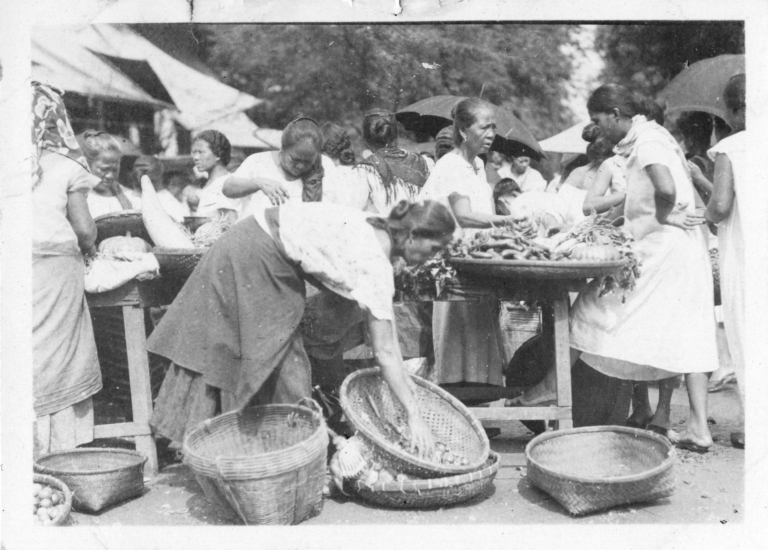This photograph originally stood out to me amongst the other many photos, due to the number of women in the photo. Seeing so many women gathered in one place with no men in sight struck me. As I began researching Southeast Asia, specifically Manila in the 1930s, I was given a new understanding of women’s role in society, how that has changed for Filipina women in the present day, and the future of Filipino society as a whole.
This image depicts Filipina women at a marketplace where the women are selling, buying, and trading local produce and products with each other. There are many baskets as well as umbrellas, and by the way, they are dressed as well as the trees in the background, it can be assumed this is a poor village in Manila. This image gives insight into the typical everyday life of Filipina women. Filipina women’s role has largely been defined by Catholicism, even in pre-colonial times. These women are expected to take care of the household, children, as well as take care of the family finances, which can be why we see women at this marketplace in Manila trading and buying goods from one another (“Women in the Philippines: Status, Stereotypes, Maria Clara, and Abuse”). While I assumed women in the Philippines at this time would be stuck at home, I was surprised to see these women on their own in town. Traditionally, Filipina women did not travel alone outside of the home without a man unless it was for selling and buying goods (“Women in the Philippines: Status, Stereotypes, Maria Clara, and Abuse”). This image can give insight into women’s duties after being colonized by the Spanish and Americans.
From the past, we are able to see the potential for how things will transpire in the future. This image gives some insight into the change Filipina women will face over the next 100 years. Women in Manilla have evolved from just running their households, to actually being the main people to occupy important positions of office (“Women in the Philippines: Inspiring and Empowered”). Women have specifically excelled in the topic of education throughout the years. As we read for class in The Formation of Filipino Nationality Under US Colonial Rule, the US colonizers helped establish an education system similar to ours in the Philippines, and since then, more and more women have gone to school and used their education to progress in life (Mojares, 2006). Literacy rates in the country now have women at 90.4% and men at 80.6%, showing that women are actually accelerating at a reading rate much faster and better than men (“Women in the Philippines: Inspiring and Empowered”).
This image is also able to give the audience an insight into the future of the location of Manila, Philippines. As stated, this image is known to have been taken around 1932-1937, nearly 100 years ago. The “market” in this image obviously is not similar to the markets we see now as the market shown seems in nature, and has very little structure. It is built off of dirt and seems to be selling produce and handmade goods. This is a drastic difference from how Manila has become over the last 100 years, where it still seems to thrive off of buying and selling goods, just in a much greater sense. Manilla has grown to be a booming city with large buildings and a city center that has grown very much from its small beginnings (Nascimento, 1991).
Overall, I feel that the meaning of this image was really to display the everyday life of women in Manila in the 1930s and to document the real environment of a typical market during this time in Southeast Asia. The photographer did an excellent job capturing the dress, style, environment, and technology used during this time. We are able to use this image to compare everyday life then and now, which teaches people the advances we have made in the world and specifically they have made in the Philippines.
The change in society from pre-colonial times to post-colonial times, to now in this region can rarely be shown except through photography. Photography can really give insights into past times that otherwise could not have been inferred.
